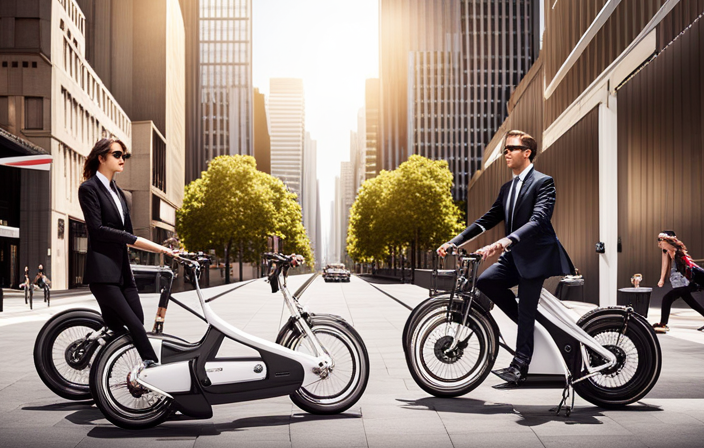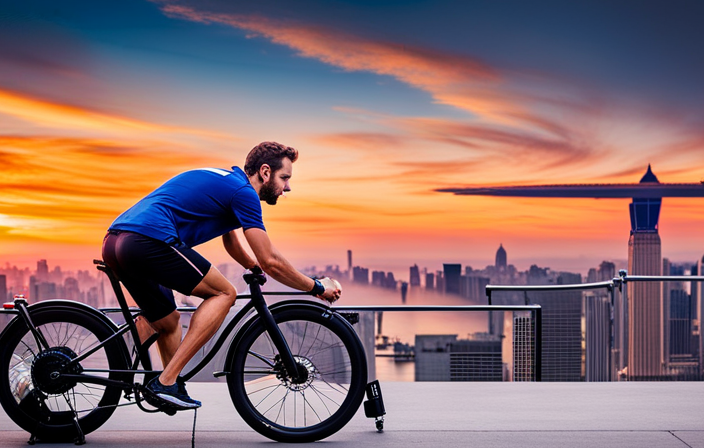Envision the excitement of smoothly sailing uphill and seamlessly navigating through traffic on your personal electric bicycle. I’m here to inform you that this isn’t merely a fantasy, but an attainable reality with some knowledge and the proper equipment.
In this article, I’ll guide you step-by-step on how to convert your bike into an electric powerhouse. Get ready to experience the freedom and convenience of electric biking like never before.
So, let’s dive right in and unlock the secrets of electrifying your ride!
Key Takeaways
- Assess bike frame strength and durability
- Evaluate battery capacity for travel distance and performance needs
- Choose the right conversion kit for specific bike requirements
- Gather necessary tools and equipment and optimize bike performance
Assess Your Bike’s Suitability for Conversion
Before you dive into converting your bike to electric, take a moment to assess if your beloved two-wheeler is up for the electrifying transformation.
The first thing you need to consider is the bike frame. A sturdy frame is crucial to support the additional weight of the electric components. Look for a strong and durable frame that can handle the extra strain.
Next, evaluate the battery capacity. Determine how far you want to travel on a single charge and choose a battery that meets your requirements. Consider factors like voltage and amp-hour rating to ensure optimal performance.
Once you’ve assessed your bike’s suitability, it’s time to choose the right conversion kit. This will be discussed in the subsequent section, which focuses on selecting the ideal kit for your bike’s specific needs.
Choose the Right Conversion Kit for Your Bike
To embark on the journey of electrifying your two-wheeled companion, first things first, you’ll need to select the perfect conversion kit for your trusty ride. Here are some conversion kit options to consider:
- Front wheel conversion kit: This kit replaces your front wheel with a motorized wheel, making installation a breeze.
- Rear wheel conversion kit: Similar to the front wheel kit, this one replaces your rear wheel for a motorized upgrade.
- Mid-drive conversion kit: This kit replaces your bike’s bottom bracket and allows the motor to directly drive the crankshaft, providing a more natural riding experience.
- All-in-one conversion kit: This comprehensive kit includes everything you need, from the motor to the battery, ensuring a seamless conversion process.
Before making a decision, it’s crucial to estimate the battery range. Consider factors such as the terrain, your weight, and desired speed to determine the right battery capacity for your needs.
Now that you have chosen the perfect conversion kit, let’s gather the necessary tools and equipment for the installation process.
Gather the Necessary Tools and Equipment
Now that you’ve chosen the perfect conversion kit, let’s gather all the tools and equipment you’ll need for the installation process.
To begin the bike conversion process, you’ll need a few key items. First, make sure you have a good set of wrenches, both metric and standard, to help with any necessary adjustments.
Additionally, you’ll need a torque wrench to ensure that all bolts and nuts are tightened to the proper specifications. A set of wire cutters and crimpers will come in handy for any electrical work that needs to be done.
Finally, don’t forget a sturdy work stand to securely hold your bike during the conversion process.
Now that we have all the necessary equipment, let’s move on to preparing your bike for conversion by removing the wheels and other components.
Prepare Your Bike for Conversion
Before beginning the conversion process, it’s important to remove non-essential components from the bike, such as the front derailleur. This will help streamline the bike and make room for the electric conversion kit.
Additionally, ensuring proper bike maintenance is crucial for a smooth and safe conversion. Checking tire pressure and making any necessary brake adjustments will ensure optimal performance once the electric components are added.
Remove Non-Essential Components (e.g., front derailleur)
First, you’ll want to strip away any non-essential components, like the front derailleur, to streamline your bike for an electric conversion. Removing the front derailleur not only simplifies the bike’s design but also eliminates unnecessary weight, optimizing bike performance. The front derailleur is responsible for shifting gears, but since an electric bike typically has a single-speed or internally geared hub motor, it becomes redundant.
To remove the front derailleur, follow these steps:
- Use a wrench to loosen the bolt securing the derailleur to the frame.
- Slide the derailleur off the chain and remove any cables connected to it.
Remember to keep the removed components in a safe place in case you decide to revert to a non-electric setup in the future.
After removing the non-essential components, it’s essential to ensure proper bike maintenance. This includes checking tire pressure, making brake adjustments, and conducting regular inspections to keep your electric bike in top shape.
Ensure Proper Bike Maintenance (e.g., tire pressure, brake adjustments)
Make sure you keep your electric bike running smoothly by regularly checking tire pressure, adjusting brakes, and conducting inspections. Proper bike maintenance is essential for both bike safety and optimal performance.
Start by checking the tire pressure regularly, as it affects the bike’s stability and efficiency. Use a pressure gauge to ensure the tires are inflated to the recommended levels.
Additionally, make sure the brakes are working correctly by adjusting them if needed. Squeeze the brake levers and check if they engage smoothly and stop the bike effectively.
Lastly, conduct regular inspections of the bike’s components, such as the chain, gears, and pedals, to identify any signs of wear and tear. This will help prevent potential issues and ensure a smooth ride.
Now, let’s move on to installing the electric motor and battery.
Install the Electric Motor and Battery
To install the electric motor and battery on your bike, you’ll want to start by finding a secure and accessible spot on the frame. This will ensure that the motor and battery are properly mounted and won’t interfere with your pedaling.
Once you’ve found the ideal location, begin by attaching the motor to the frame using the provided mounting brackets and screws. Make sure it is tightly secured to avoid any movement during rides.
Next, connect the battery to the motor using the designated cables and connectors. Ensure that the connections are secure and free from any loose wires.
Once the motor and battery are installed, you can move on to the next step of connecting the electric system to your bike, which will allow you to control the motor’s power and monitor the battery’s charge.
Connect the Electric System to Your Bike
Now that you’ve got the motor and battery in place, it’s time to bring the electric system and your bike together, like two long-lost friends finally reunited. The electric system installation is a crucial step in converting your bike to electric. To ensure a successful installation, follow these step-by-step guidelines:
-
Connect the motor controller: Locate the motor controller wires and connect them to the corresponding wires on the electric motor. Ensure a secure connection by double-checking the color-coding.
-
Attach the throttle: Connect the throttle wires to the motor controller. Make sure to align the throttle properly and secure it in place.
-
Connect the battery: Connect the battery wires to the motor controller. Take extra care to match the positive and negative terminals correctly.
Remember, troubleshooting and maintenance are vital aspects of electric system installation. Regularly check for loose connections, damaged wires, or any signs of malfunction. Now, let’s move on to the next step: testing and adjusting the electric system.
Test and Adjust the Electric System
Once you’ve reunited your bike with its long-lost electric system friend, it’s time to put them to the test and fine-tune their performance. Here’s what you need to do to ensure your electric system is working optimally:
- Start by conducting a thorough test of the entire system, including the battery, motor, and controller.
- Record the test results to identify any issues or areas that need improvement.
- Based on the test results, make necessary adjustments to the system, such as increasing or decreasing the motor power or adjusting the controller settings.
- Test the system again after making adjustments to gauge the impact on performance.
- Repeat the process until you achieve the desired performance and efficiency.
Once you have tested and adjusted the electric system, it’s crucial to ensure safety and compliance with local regulations.
Ensure Safety and Compliance
Ensuring safety and compliance is crucial for the well-being of both you and your community. When converting your bike to electric, it is important to adhere to bike safety and compliance regulations. This will not only keep you safe while riding, but also ensure that your electric bike meets legal requirements. To help you understand the necessary safety measures and regulations, here is a table outlining some key aspects:
| Aspect | Safety Measure | Compliance Regulation |
|---|---|---|
| Brakes | Check brake pads and adjust for optimal stopping power | Ensure the bike meets minimum braking requirements |
| Lights | Install front and rear lights for visibility | Comply with local laws regarding bike lighting |
| Speed | Set a maximum speed limit for your electric bike | Abide by speed restrictions for electric bicycles |
By following these safety measures and compliance regulations, you can enjoy a safe and legal electric bike. Now, let’s move on to learning how to ride your electric bike safely and efficiently.
Learn to Ride Your Electric Bike Safely and Efficiently
To ride your electric bike safely and efficiently, remember the saying ‘smooth and steady wins the race.’
When it comes to electric bike riding, it’s important to maintain a steady pace and avoid sudden accelerations or decelerations. This not only ensures your safety but also helps in conserving battery power.
Before you start riding, make sure to check your electric bike’s maintenance needs. Regularly inspect the brakes, tires, and chain to ensure they are in good condition. It’s also important to wear proper safety gear, such as a helmet and reflective clothing, and follow traffic rules.
Additionally, always be aware of your surroundings and use hand signals when turning or changing lanes. By following these electric bike safety precautions and maintaining your bike regularly, you can enjoy a safe and efficient ride.
Now, let’s move on to the next section on how to maintain and service your electric bike regularly.
Maintain and Service Your Electric Bike Regularly
Now that you have learned how to ride your electric bike safely and efficiently, it is crucial to maintain and service it regularly to ensure its optimal performance. Proper bike maintenance and regular service are essential to keep your electric bike in top shape and prolong its lifespan. Here are a few key steps to follow:
- Clean your electric bike regularly to remove dirt and debris.
- Check and tighten all nuts, bolts, and screws to ensure they are secure.
- Inspect the tires for wear and tear and maintain the appropriate tire pressure.
- Keep the chain lubricated for smooth and efficient pedaling.
- Regularly check the battery and charging system to ensure they are functioning correctly.
By following these maintenance steps, you can ensure that your electric bike operates at its best.
Now, let’s transition into the next section and explore how to enjoy your electric bike and discover new riding opportunities.
Enjoy Your Electric Bike and Explore New Riding Opportunities
Let’s kick back, hop on your e-bike, and embark on exciting adventures to uncover new paths and unforgettable experiences. As you enjoy your electric bike, you may find yourself wanting to explore even more riding opportunities. Luckily, there are always new electric bike models and accessories to enhance your experience.
To keep up with the latest trends, stay informed about the newest electric bike models available. These models often come with improved features, such as longer battery life, better suspension, and advanced motor technology. Additionally, consider investing in electric bike accessories like panniers, racks, and lights to make your rides more convenient and safe.
To help you make the best choices, I have created a table listing some popular electric bike models and accessories:
| Electric Bike Models | Electric Bike Accessories |
|---|---|
| Model A | Panniers |
| Model B | Racks |
| Model C | Lights |
| Model D | Helmets |
| Model E | Locks |
By staying up to date with new electric bike models and investing in accessories, you can enjoy your e-bike to the fullest. Now, let’s transition into the next section and share your electric bike conversion experience with others.
Share Your Electric Bike Conversion Experience with Others
Share the joy of your electrifying transformation with others and inspire them to embark on their own exhilarating journey. Converting a bike to electric may seem challenging, but with the right knowledge and guidance, it can be a rewarding experience.
Here are some tips for maximizing electric bike performance:
- Battery selection: Choose a high-quality battery with a long-lasting charge to ensure maximum power and range.
- Motor placement: Properly position the motor on your bike to achieve optimal balance and control.
- Rear-wheel motor: Provides better traction and stability, especially for off-road adventures.
- Mid-drive motor: Offers a more natural riding experience by utilizing the bike’s gears.
By sharing your electric bike conversion experience, you can help others overcome challenges and make informed decisions. Consider upgrading or modifying your electric bike to further enhance its performance and meet your specific needs.
Consider Upgrading or Modifying Your Electric Bike
Enhance your electric ride by upgrading or customizing it to suit your specific needs, unlocking a world of endless possibilities and exhilarating adventures.
When it comes to upgrading your electric bike, there are several options to consider. First, you can upgrade the battery to extend your ride time and distance. Look for a higher capacity battery that fits your budget, ensuring you can enjoy longer journeys without worrying about running out of power.
Additionally, you can upgrade the motor to increase speed and power, providing a thrilling ride experience. Consider your budget considerations when deciding on the specific upgrades to make.
By upgrading or modifying your electric bike, you can create a personalized ride that perfectly fits your preferences. This will help you spread the benefits of electric bikes and sustainable transportation to others, encouraging them to join the movement towards a greener future.
Spread the Benefits of Electric Bikes and Sustainable Transportation
As an expert in electric bikes and sustainable transportation, I strongly advocate for the development of electric bike infrastructure and policies.
By investing in dedicated bike lanes, charging stations, and bike-friendly infrastructure, we can make electric bikes a viable and convenient mode of transportation for everyone.
Additionally, it is important to encourage others to try electric bikes by highlighting their numerous benefits, such as reducing emissions, saving money on fuel, and promoting physical activity.
With my technical knowledge and step-by-step guidance, I can help you navigate the world of electric bikes and spread the benefits of sustainable transportation.
Advocate for Electric Bike Infrastructure and Policies
Encourage local governments to prioritize the development of electric bike infrastructure and implement policies that support this clean and sustainable mode of transportation.
Electric bike infrastructure plays a crucial role in promoting the use of electric bikes and increasing their accessibility. Governments should invest in building bike lanes, charging stations, and secure parking facilities for electric bikes. Additionally, they can incentivize businesses to install charging stations at their premises.
Government policies should also include initiatives such as tax credits and subsidies to make electric bikes more affordable for the general public. By creating a supportive environment for electric bikes, governments can encourage their adoption and contribute to reducing carbon emissions and traffic congestion.
With proper infrastructure and policies in place, electric bikes will become a convenient and efficient mode of transportation for people of all ages and fitness levels. Encouraging others to try electric bikes is the next step towards creating a sustainable transportation culture.
Encourage Others to Try Electric Bikes
Spark the interest of others to take a spin on the eco-friendly e-ride and experience the exhilaration of effortless exploration. Encouraging the community to try electric bikes not only promotes health but also contributes to a greener and more sustainable future.
To get others on board, start by sharing your own positive experiences and the benefits you’ve gained from riding an electric bike. Highlight how it has improved your fitness level and overall well-being.
Organize group rides or events to create a sense of community and camaraderie. Spread the word through social media, local newsletters, and community forums.
By showcasing the advantages of electric bikes and encouraging others to give them a try, we can create a ripple effect that will lead to more people embracing this eco-friendly mode of transportation.
As we move forward, staying updated on the latest electric bike technology and innovations will ensure that we continue to promote and advocate for this exciting form of transportation.
Stay Updated on the Latest Electric Bike Technology and Innovations
Stay in the loop and discover the newest electric bike technology and innovations to take your bike to the next level. Here are four key ways to stay updated on the latest electric bike designs and electric bike market trends:
-
Follow industry-leading blogs and websites that specialize in electric bikes. These sources often provide detailed reviews and analysis of the latest electric bike models and advancements.
-
Join online forums and communities dedicated to electric bikes. Engage with fellow enthusiasts and experts who can share their experiences and knowledge about the latest trends and technologies.
-
Attend electric bike trade shows and exhibitions. These events showcase the newest electric bike designs and innovations, allowing you to see them firsthand and speak with manufacturers and industry experts.
-
Subscribe to newsletters and email updates from electric bike manufacturers and retailers. They often share information about new products, technological advancements, and special offers.
By staying informed and up to date, you’ll be able to make well-informed decisions when converting your bike to electric and take advantage of the latest technology and designs available in the market.
Frequently Asked Questions
Can I convert any type of bike to electric?
Yes, you can convert almost any type of bike to electric. The advantages of electric conversion include increased speed and range, reduced effort while pedaling, and the ability to tackle hills and rough terrains with ease.
How much does a conversion kit cost?
Converting a bike to electric with a conversion kit can cost anywhere from $200 to $1000, depending on the quality and features. The benefits include increased speed, longer range, and the ability to tackle hills with ease.
Are there any specific tools required for the conversion process?
To complete the conversion process of converting a bike to electric, specific tools are required. These tools include a wrench set, screwdrivers, wire cutters, and a soldering iron. Each tool plays a crucial role in the successful transformation.
Can I still pedal my electric bike?
Yes, you can still pedal an electric bike. Pedaling efficiency may vary depending on the type of electric bike and the assistance level you choose. Pedaling an electric bike can still provide health benefits and allow you to exercise while enjoying the electric assistance.
Are there any legal restrictions or regulations for riding an electric bike?
Licensing requirements and safety regulations for riding an electric bike differ by country and state. In the US, electric bikes with a maximum speed of 20 mph are usually considered bicycles, so no license is required. However, it’s important to check local laws.
Conclusion
In conclusion, converting my bike to electric has been a transformative experience. It’s like giving wings to a bicycle, as it effortlessly glides through the streets, leaving a trail of amazed onlookers.
The freedom and convenience of an electric bike are unmatched, and the sustainable nature of this transportation option is truly remarkable. With the right conversion kit and a little technical know-how, anyone can embark on this journey and enjoy the benefits it brings.
So, join the electric bike revolution and pedal into a greener and more exciting future!








